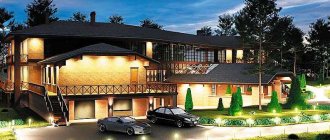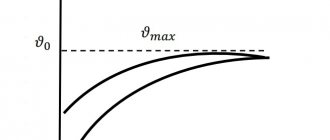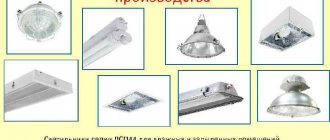To supplement and replace natural light at night, there is a need for artificial lighting. High-quality artificial lighting ensures safety on the streets and roads of urban and rural settlements, reduces the number of accidents on highways and pedestrian crossings at night, and also helps prevent criminal acts.
Illumination standards are generally accepted and regulated by SNiP document 05/23/2010, including SP 52.13330.2011.
These documents regulate lighting requirements for the following objects:
• Lighting standards for streets and roads in urban settlements
• Lighting standards for streets and roads in rural settlements
• Illumination standards for underground and overground passages
• lighting standards for gas stations and parking lots
• Lighting standards for pedestrian spaces
Street lighting standards depend on the type of streets and roads, as well as on the functional features of the illuminated objects.
One of the main standardized indicators is the average horizontal illumination at ground or road surface level. The tables below show some values of the standards, according to SP 52.13330.2011.
Standards for lighting streets, roads and squares
| Category | Class | Illuminated objects | Throughput, thousand units/h | Average illumination of the road surface Еср, lux, not less |
| A | A1 | Highways, federal and transit routes, main city thoroughfares | Over 10 | 30 |
| A2 | Other federal roads and main streets | 7—9 | 20 | |
| A3 | Central highways connecting streets with access to the A1 highway | 4—7 | 20 | |
| A4 | Main historical passages of the center, internal connections of the center | 3—5 | 20 | |
| B | B1 | Main roads and streets of the city of regional significance | 3—5 | 20 |
| B2 | Same | 2—5 | 15 | |
| IN | IN 1 | Transport and pedestrian connections within residential areas and access to highways, except for streets with continuous traffic | 1,5—3 | 15 |
| AT 2 | Transport and pedestrian connections in residential areas, access to highways | 1,5—3 | 10 | |
| AT 3 | Transport connections within production and utility-warehouse areas | 0,5—2 | 6 |
Street lighting standards limit the brightness of luminaires when installed at angles.
The angle of inclination of the lamp should be 80 and 90 degrees from the vertical towards the road.
Maximum brightness value
Installation angle 80 degrees – 30 cd
Installation angle 90 degrees – 10 cd
per 1000 lm of luminous flux of the lamp.
When illuminating large areas and traffic intersections, lamps installed on supports with a height of 20 m or more must ensure the direction of maximum light intensity at an angle of no more than 65 degrees from the vertical.
The brightness of the lamp at an angle of 80, 85 and 90 degrees from the vertical in the direction of the road should not exceed the following limit values:
Installation angle 80 degrees – 50 cd
Installation angle 85 degrees – 30 cd
Installation angle 90 degrees – 10 cd
accordingly, per 1000 lm of luminous flux of the lamp.
Standards for lighting streets and roads in rural settlements
| № | Illuminated objects | Average horizontal illumination, lux |
| 1 | Main streets, squares, public and shopping centers | 10 |
| 2 | Residential streets: Basic Secondary (alleys) | 6 4 |
| 3 | Village roads, driveways on the territory of gardening partnerships and dacha cooperatives | 2 |
Types of supporting structures, their location
Lampposts for street lighting must satisfy two main requirements: efficiency and a high degree of reliability.
Various types of supports
There are several types of street lighting support structures based on differences in the materials used:
- Wooden;
- Metal;
- Concrete;
- Polymer.
The first option mentioned earlier was very popular due to the lack of more technological solutions, but today wooden street lighting poles can most often be found only in remote villages.
Preferred are concrete and metal versions. Polymer poles are usually used as an addition to the decor. Not only a pole, but also a mast can act as a supporting structure for a lampshade and any type of lamp, including LED lighting.
If it is not practical to install individual lighting poles (it is not economically profitable or there is no physical possibility), it is allowed to mount the lamps on the supporting structures of the contact network. Metal and concrete poles are used to organize a citywide lighting system.
In cases where it is not possible to install supports due to plantings, the preferred option is with a cable and fastening cables. In this case, the distance between the lamps must be maintained.
Requirements for the location of supports
First, you should consider diagrams of the possible location of lamps along the roads:
- One-sided;
- Double-sided (chess);
- Double-sided (rectangular);
- Axial;
- Double-row rectangular (location along the axes of movement);
- Double-row rectangular (location along the axes of the street).
Depending on the type of object, the appropriate scheme is selected. For example, if we are talking about alleys, then a one-sided arrangement of pillars will be preferable, provided that the width of the alley exceeds 10 m. If it is more than this value, then a rectangular or double-row checkerboard pattern is used.
Schemes for the location of lamps along roads
The distance between the pillars is determined by the power of the lamps used in the lamps. The higher the lighting intensity, the farther the supports can be located from each other. As for what distance is considered acceptable between the pole and the curb of the road, building codes and regulations regulate the following restrictions:
- The distance between the support and the curb corresponds to 1 m, provided that the traffic on the road is quite intense;
- On minor roads, a distance of 0.6 m between the support and the curb is considered normal;
- If there is no freight transport, a distance of 0.3 m can be taken as the norm;
- In the case where there is no curb at all, the support is installed at a distance of 1.75 m from the edge of the road.
If it is necessary to organize lighting on a section of road with a curve from 60 to 250 m, the poles are located on the outside. Otherwise, it is allowed to install supporting structures from the inside, provided that the distance between them is increased. The minimum and maximum installation height of the lamp with shade is also specified. Depending on the type of lighting device used, the value of this parameter can vary from 3 to 4 m.
Design features
Without exception, all poles (metal, concrete and others) must be resistant to strong gusts of wind (up to 160 km/h). From this point of view, metal supports are a more preferable option, since they are equipped with stiffening ribs in the shape of a circle or polyhedron. Such structures have a large base area and taper towards the top, which greatly contributes to stability.
Supports are divided into groups according to height:
- From 3 to 12 m, used for lighting parks and residential areas;
- Metal poles with a height of more than 12 m are used for lighting municipal facilities, stadiums, sports grounds, and ports.
As for the foundation, there are a number of requirements that must be taken into account when arranging a lighting system:
- The base of the supporting structure can be located on top of the ground and below its level (ground and underground foundation blocks).
- The dimensions of the base must correspond to the intended purpose of the pillar, its height, and the type of soil.
- To install, you need to obtain a land work permit.
The depth of the foundation may vary: 0.8 m or less for lawns, 1.25 m or more for roadways.
Types of brackets
Lamps with shades are installed on a special fastening element called a bracket. This part is made of steel and can be coated with paints or galvanization.
Types of brackets:
- Single;
- Double;
- Gander-shaped for one or more lampshades;
- Wall-mounted, L-shaped;
- Headband;
- Floor lamp type.
Each type is used on different objects.
Organization of lighting control
There are two ways to control the functioning of lamps: manual and automatic. It is more advisable to use the second option, which can be implemented in several ways:
- Photo relay.
- Motion Sensor.
- Timer.
Thus, the key points in organizing a lighting system include the distance between supporting structures, the type of material from which the pillars are made, the height of the supports, and the type of foundation. In addition, the power of the light bulbs, the type of road surface and the distance between the pole and the curb are taken into account.
Lighting standards for underground and overground pedestrian crossings
| № | Illuminated objects | Esr, lx, no less |
| 1 | Underground pedestrian tunnels and passages: passages stairs and ramps | 75 40 |
| 2 | Open footbridges | 10 |
| 3 | Overhead pedestrian crossings with transparent walls and ceilings or glazed wall openings: passages staircases, ramps and viewing platforms | 75 50 |
Courtyard lighting - how to properly illuminate
Any actions that relate to the organization of lighting in a house, on the street or in any public or industrial structure must be based on specific norms, rules and requirements. Many today think that the requirement is relevant only for premises where people do their work or relax. But this is a misconception, since improperly organized street lighting can cause no less harm to people’s lives and health than indoor lighting. All standards that relate to what kind of lighting should be provided for an apartment building and the surrounding area are specified in the regulatory documentation - SNIP. At the same time, a big role here is given to the level of illumination, which must be organized in each specific situation. Below is a table that shows the illumination standards for certain moments of external lighting in the local area.
Standards for illumination of the local area
It is these lighting standards that should be relied upon by organizations involved in the creation of street lighting for houses and the surrounding area.
Note! The illumination standards given in SNIP are advisory in nature and may be slightly modified (but not lower than the established values) when certain parameters change. At the same time, we must strive to ensure that these standards are met as accurately as possible. Indeed, if there is a significant deviation from them, the quality of street lighting will decrease.
At the same time, cities and villages have their own lighting standards, dictated by various parameters and characteristics of the locality. For example, to influence the calculation that will be carried out to calculate the illumination standard for a particular case, it should be based not only on the instructions of SNIP, but also on:
- the area of the house, as well as the territory adjacent to it;
- the number of lighting fixtures that will be included in the outdoor lighting system, as well as their type;
Note! House lighting can be provided by various types of lighting devices: lanterns, spotlights, wall lamps, etc. Moreover, each type of backlight will be characterized by its own technical operating parameters.
House lighting fixtures
- type of light source screwed into street-type lamps. Today, incandescent lamps, on the basis of which illumination standards were calculated for various rooms and areas of the street, are becoming a thing of the past. Instead, LED, halogen and fluorescent light sources are increasingly being used. Each type of light bulb has its own operating parameters (power, etc.), which must be taken into account when making the necessary calculations.
All these manipulations and calculations, which are necessary for high-quality lighting of the house and the surrounding area, must be carried out by qualified specialists and regulated by government agencies responsible for street lighting.
Lighting standards for gas stations and parking lots
| № | Illuminated objects | Average horizontal illumination, lux |
| Gas stations | ||
| 1 | Access routes from streets and roads: Category A and B Category B | 15 10 |
| 2 | Places for refueling and discharging petroleum products | 20 |
| 3 | The rest of the territory with a roadway | 10 |
| Parking lots and storage areas for rolling stock | ||
| 1 | Open parking on streets of all categories, as well as paid off-street parking, open parking in neighborhoods, driveways between rows of box-type garages | 6 |
Requirements for utilitarian lighting
Console lamps
This type of lighting is organized in those areas where a level of 10-40 lux is sufficient. This function falls on the shoulders of console lamps, which are installed at a height of 5-8 meters. They are placed around the entire perimeter of the school.
Such lighting fixtures are placed on steel and faceted supports of the OGK type. They, compared to reinforced concrete supports, have significantly more advantages in terms of aesthetics and technical characteristics. Lamps providing utilitarian lighting are mounted on faceted steel supports in three ways:
- single-horn or two-horn method;
- floor lamp installation method;
- using bracket elements.
This method of illumination allows for high-quality and even illumination of the entire school area.











